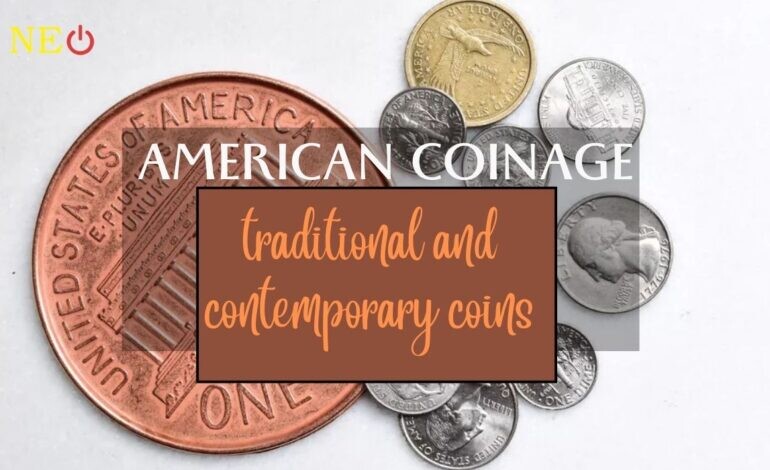RBI Fines Indian Banks: Reasons for ₹1.29 Crore Fines Against Banks
The Reserve Bank of India (RBI) fined ₹1.29 crore on three prominent banks: Kotak Mahindra Bank, IDFC First Bank, and Punjab National Bank. Examine Why?

The wide variety of coins available for collection is one of the pleasures of coin collecting in the United States. The diversity and difficulties that come with collecting United States coins, including modern date coins, out-of-date denominations, and commemorative coins, can sustain your interest in coin collecting for a lifetime.
American coinage

The smallest denomination, but almost as large as a contemporary quarter. The half cent was useful for making change in its early years of circulation because it was made of pure copper. The half cent, however, lost its usefulness as time went on and products became more expensive, and it was abandoned just before the Civil War. All half cents are now in short supply. On the obverse of each type is a bust of Liberty, while the reverse is a wreath.

Along with the half cent, one of the first two coins struck by the United States, all the large cents were coined at the Philadelphia Mint. With twice the copper of the half cent, they were large and heavy – greater in size than today’s quarter – so a pocketful was quite bulky. As the price of copper rose during the 1800s, the large cent became too expensive to produce and was replaced in 1857 by the small cent.

The Flying Eagle, the first little cent in America, was released in 1856. Because it is composed of 88% copper and 12% nickel, it is known as the "white cent." James Longacre created the Flying Eagle cent, which was only in circulation for three years before being replaced by the Indian Head cent.
The Lincoln cent was the country's first to feature a president in 1909. The Lincoln Memorial was added in 1959, replacing the "Wheat Ears" reverse style that it had previously used. Then, four distinct reverse designs were made available in 2009 to commemorate the 100th anniversary of the series and the bicentennial of Lincoln's birth. In 2010, a brand-new reverse pattern with the Union Shield debuted.

The 1864 Coin Act also called for a 2¢ copper coin. This Civil War-era coin was America’s first and only 2¢ piece. It was the first coin to carry IN GOD WE TRUST.

The 3¢ piece is the smallest of all U.S. silver money. Because it was struck in silver, the public hoarded it along with other coins when the Civil War broke out. Since the 3¢ piece was needed to help ease the shortage caused by war, the U.S. Mint decided to strike it in copper-nickel.

The 3¢ nickel, so called because of its copper-nickel composition, was well received by the public. This helped the nation retire the unpopular 3¢ paper notes issued during the Civil War. Once the majority of notes had been exchanged for 3¢, and production of 5¢ nickels and cents increased, the banks needed fewer 3¢ pieces.

In 1866, the nation’s first 5¢ coin of non-precious metal was created: the Shield nickel. The prior (and first) U.S. 5¢, the half dime, was silver. In 1883 came the Liberty Head or “V” nickel, followed by the extremely popular Buffalo nickel of the early 20th century, and then the long-running Jefferson nickel. In 2004, new Westward Journey Jefferson nickels were released. Commemorating the Bicentennial of the Lewis & Clark expedition, two new reverse designs were issued annually. In 2006, the popular series ended with the “Return to Monticello”.

Minted in fine silver, the famous half dime was the nation’s first 5¢ coin. It was smaller and weighed less than a nickel. Several design types were issued long before the U.S. nickel denomination began. From 1866-1873, both the half dime and nickel were struck. The half dime played an integral role in the early life of America, and is of great historic and numismatic importance.

The 10¢, or dime, follows closely the designs of the half dime through the Liberty Seated type. And until 1964, when production of circulating silver coinage was ceased, all circulating dimes were minted in fine silver. Dimes in higher grades are scarce and expensive, since this denomination was used extensively compared to quarters and halves. But many early dimes are still available in circulated condition at a more reasonable cost.

The shortest-lived coin denomination in U.S. history! The twenty-cent piece, minted in 90% fine silver, was struck for circulation only in 1875 and 1876. A few hundred Proofs were coined in 1877-1878. Soon after, people complained that it was too close in design and size to the quarter – causing problems in making change. Fewer than 1.4 million were minted, so the twenty-cent piece is a scarce and treasured item today.

Because of the practice of cutting up the Mexican 8 Reales into eight parts (thus the “Piece of Eight” name), the U.S. quarter, as ¼ of a dollar, became known as “two bits.” As a silver coin of substantial size until 1964, the quarter has always been popular – both in circulation and among collectors. Several designs have been used since 1796, and many collectors try to assemble at least one of each type.Statehood, D.C. & U.S. Territories Quarters

A new era of collecting began with the start of America’s 50 State Quarters Program in 1999. From 1999-2008, every state in the Union was honored in the order they joined, or, in the case of the 13 original colonies, the order they ratified the Constitution. In 2009, an additional six quarters were issued, honoring the District of Columbia and five U.S. territories. America's National Park Quarters

In 2010 another series, modeled after the Statehood quarters, began – this time honoring America’s national parks and historic sites. Designs are scheduled to be released until 2021 for each of the 50 states, D.C., and the five U.S. territories in the order their locations first became national sites.

Though the half dollar is almost forgotten today, it was once the major silver coin of circulation. At one time, a half dollar was often more than a person made in a day’s labor. To have one, or perhaps two, was a significant stash of money. Because the half dollar is seldom seen today, it continues to grow in popularity.

Early silver dollars represent the remarkable era in America’s history when the colonies united to form what would become one of the greatest nations on Earth. Since precious silver ore was scarce in that era, the dollars of that period have very low mintages. Silver dollars were not minted between 1804 and 1836, so those that still circulated were scarce and hoarded. In addition to the early dollars pictured, a number of so-called “Gobrecht” dollars were issued between 1836-1839, and served as patterns for the Liberty Seated dollar.

The U.S. dollar of the late 19th century to the present are among the most sought-after collector issues. These include Trade, Morgan, and Peace dollars struck in 90% silver, as well as the Eisenhower dollars, which were the last large-size $1 coins struck for circulation. Susan B. Anthony began a new era of small-size U.S. dollars, and were followed by the Sacagawea dollars of 2000 to 2008, and the new Presidential dollar series introduced in 2007. Though originally issued for circulation, beginning in 2012 the Presidential dollars were issued in limited quantities for collectors only.

Between 1795 and 1933, the U.S. Mint produced various gold coins in the denominations of $1, $2.50, $3, $5, $10 and $20 (plus a few extremely rare $4 pattern pieces). These were minted in one of the world’s most precious metals, and designed by some of the finest artists of the day. Mintages were quite small, and many have been melted down over the years, so U.S. gold are of particular scarcity and interest today. Since 1986, American Eagle gold bullion have been issued just for collectors. For many, gold bullion with their unmatched beauty and worldwide popularity represent the apex of enjoyment in numismatics.

Official U.S. commemoratives are authorized by Act of Congress to honor important persons, locations, and events in U.S. history. Commemoratives have been struck in both silver and gold, and more recently, clad. They are minted only in very small numbers compared to regular coinage. After 1954, no U.S. commemoratives were produced until 1982, when the George Washington half dollar was issued to commemorate the 250th anniversary of Washington’s birth. Official U.S. issues should not be confused with so-called “commemoratives” produced by private organizations, which are medals.
The Reserve Bank of India (RBI) fined ₹1.29 crore on three prominent banks: Kotak Mahindra Bank, IDFC First Bank, and Punjab National Bank. Examine Why?
GDP growth slows down to 5.4% in the second quarter, putting more pressure on the RBI to lower interest rates.
The Indian stock market is showing a flat start today. The Gift Nifty was around 24,540, which is just 2 points higher than the last closing value of the Nifty futures.

